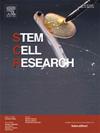来自晚发性Tay-Sachs病(hexa相关成年性gm2神经节脂质沉积症)患者的三种人诱导多能干细胞(hiPSC)系的生成
IF 0.7
4区 医学
Q4 BIOTECHNOLOGY & APPLIED MICROBIOLOGY
引用次数: 0
摘要
迟发性Tay-Sachs (LOTS)病是由与溶酶体酶β-六糖氨酸酶a缺乏相关的HEXA基因突变引起的,最终导致神经节苷脂GM2的积累。Tay-Sachs病表现出不同年龄的神经学表现,主要表现为脊髓运动神经元(SMN)变性。c.805G >;在lot患者中,HEXA基因的A (p.Gly269Ser)突变最为常见,并且与较高的残留活性相关。然而,由于没有相关的实验模型来研究lot, SMN退化的机制尚不清楚。本文章由计算机程序翻译,如有差异,请以英文原文为准。
Generation of three human induced pluripotent stem cell (hiPSC) lines from patients with Late-Onset Tay-Sachs disease (HEXA-related adult-onset GM2-gangliosidosis)
Late-Onset Tay-Sachs (LOTS) disease is caused by mutations in the HEXA gene associated with a deficiency in the lysosomal enzyme β-hexosaminidase A, ultimately leading to an accumulation of ganglioside GM2. Tay-Sachs disease presents with heterogeneous neurological manifestations depending on age at onset, LOTS being specifically characterized by spinal motor neuron (SMN) degeneration. The c.805G > A (p.Gly269Ser) mutation in the HEXA gene is the most frequent in patients with LOTS and associated with a higher residual activity. Nevertheless, the mechanisms underlying SMN degeneration are unknown, given that there is no relevant experimental model to study LOTS.
求助全文
通过发布文献求助,成功后即可免费获取论文全文。
去求助
来源期刊

Stem cell research
生物-生物工程与应用微生物
CiteScore
2.20
自引率
8.30%
发文量
338
审稿时长
55 days
期刊介绍:
Stem Cell Research is dedicated to publishing high-quality manuscripts focusing on the biology and applications of stem cell research. Submissions to Stem Cell Research, may cover all aspects of stem cells, including embryonic stem cells, tissue-specific stem cells, cancer stem cells, developmental studies, stem cell genomes, and translational research. Stem Cell Research publishes 6 issues a year.
 求助内容:
求助内容: 应助结果提醒方式:
应助结果提醒方式:


